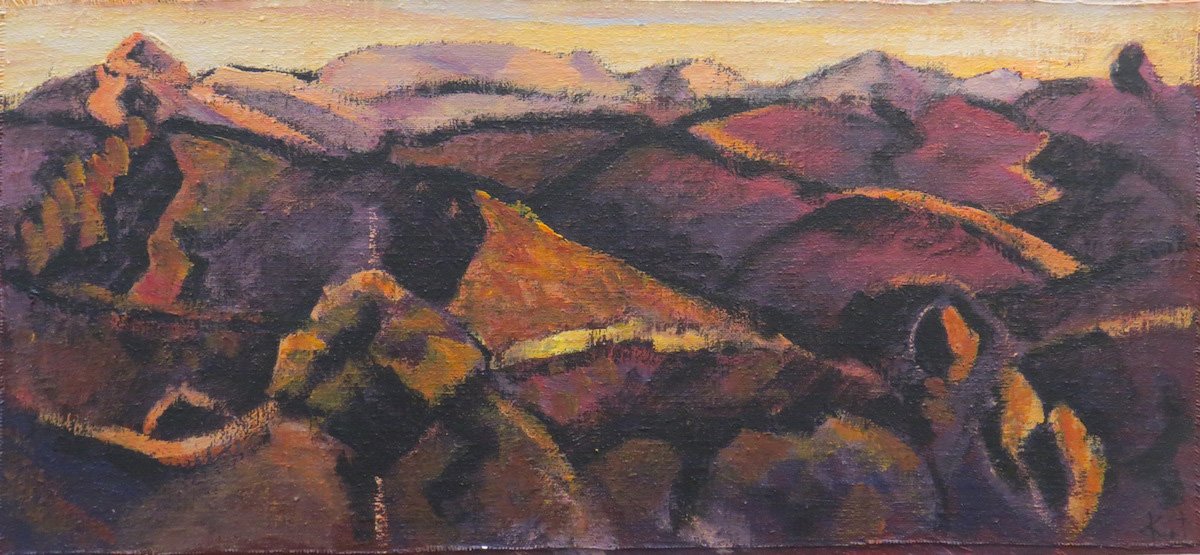In this week's Art Seen, James Dignan looks at exhibitions from Moray Gallery, Hocken Collections, and Chris Charteris
 From the Kilmog 2, by Kit Macgregor
‘‘Contrasts’’, Alison Bevers and Kit Macgregor (Moray Gallery)
From the Kilmog 2, by Kit Macgregor
‘‘Contrasts’’, Alison Bevers and Kit Macgregor (Moray Gallery)

‘‘Contrasts’’ is an appropriate name for the current exhibition at Moray Gallery. It features the works of two artists with widely disparate styles, both of whom are fascinated by the interplay of colour, light and shade.
With Kit Macgregor, this interplay is explored in a natural setting, with a series of strong landscape works, predominantly of hills around the Kilmog. The artist makes use of strong areas of bold yet muted colour separated by rough areas of dark shadow, and details are implied rather than depicted directly. The rich light of the low-angled sun causes the land to distort into pink and orange hues in works such as From the Kilmog 2. Macgregor also experiments with texture, with many of the works painted on hessian stretched over board, to pleasant effect.
Alison Bevers also examines colour, texture and light, but in a diametrically opposite style. Where Macgregor’s work is impressionism by way of Woollaston, Bevers is geometrical abstraction by way of Albers. The artist’s mixed media works present repeated blocks of textured circles in grids, and explore the juxtaposition of shade and tone. The hypnotic rhythms and subtle differences within each grid allow for both repeated inspection and meditation.
Despite the different approaches of the two artists, the sets of works complement each other well.
 Your HEALTH is Your WEALTH, by Dame Robin White
‘‘Primary Care’’ (Hocken Collections Gallery)
Your HEALTH is Your WEALTH, by Dame Robin White
‘‘Primary Care’’ (Hocken Collections Gallery)

‘‘Primary Care’’ combines paintings, photographs, and ephemera to present a cross-section of institutional attempts at healthcare, from the pioneering to the sinister.
The main room of the gallery is haunted by the ghosts of Seacliff, with the hospital presented in all its apparent architectural glory in
George O’Brien’s watercolour. Juxtaposed nearby are two Dadaist-inspired works by Ava Seymour depicting state houses. Sadly, Seacliff’s design eventually proved to be fatal; so too, the state house has declined in the nation’s consciousness in recent years, with connotations of leaking slums and meth-lab contamination.
As if to reinforce the comparison, Ann Shelton’s photographic study of a dilapidated Seacliff cell block is presented alongside.
Several of the main room’s other works are by Lionel Terry — a poet, artist, and murderer who was for many years resident in Seacliff Hospital. His face stares down knowingly from a self-portrait, as if to challenge the viewer.
The two end galleries feature printed ephemera, including vintage posters which would have once graced doctors’ waiting rooms. Several publications are also presented, along with Simon Denny’s video timeline of
New Zealand healthcare. Two major works also hang in these end galleries: a surreal Heather Straka photographic work, and a lithograph on the theme of health by noted American conceptual artist Robert Rauschenberg.
 Guidance, by Chris Charteris
‘‘Truth, Simplicity, and Love’’, Chris Charteris (Milford Gallery)
Guidance, by Chris Charteris
‘‘Truth, Simplicity, and Love’’, Chris Charteris (Milford Gallery)

Chris Charteris reaches beyond the implacable solidity of bone and stone in his latest exhibition, exposing the mauri and wairua (the life force and soul) of the taonga.
In a series of impressive works, the artist has shaped granite, basalt, pounamu and whalebone into forms which are weighty not just in physicality, but also in the power which the artist has revealed.
The works form three major groups, with several further individual items which fall outside those groups. Charteris’ ‘‘earth necklaces’’, oversized jewellery decorated with beads of granite, form a contemplative centre to the display, tempting us to comprehend their untold stories. Around these, ‘‘ceremonial objects’’ of rough and highly polished stone, seemingly demanding they be touched to complete a mystic connection, lie like inexplicable archaeological relics. Several of these works hint at violent use, in the title Patu and the missile-like form of Conflict Resolution.
Most startlingly, the artist presents several thin circular slices of pounamu, displayed within lightboxes so that their translucence becomes apparent. The stone comes alive, becoming the irises of eyes. This is perfectly fitting given the exhibition’s feeling of spirituality. Wairua is closely associated with the eyes, and pounamu is regarded as rich in mauri. The combination, enhanced by the inevitable feeling of the art watching gallery visitors, creates a very strong impression.











